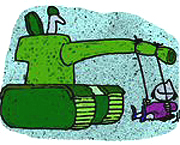
In April Dutch Defence minister Hillen announced long-expected defence cuts as part of austerity measures in response to the economic crisis. As much as 12,000 jobs will be lost over the next year and some 6,000 people will lose their jobs. Sad as this may be for the people involved, even after the cuts the military will be one of the largest employers in the country with some 54,000 people on the payroll.
Besides cuts in personnel spending there will be cuts in hardware too. Significant amounts of soon to be surplus weapons will move to the sales department of the Ministry of Defence, where they will join a number of other systems still for sale since the previous cuts of 2007.
Just over two decades ago Dutch soldiers were trained to face the Soviet threat with large numbers of tanks. On Monday soldiers drove their Leopard for the last time – no more battle tanks for the Netherlands. The 74 remaining Leopard 2s will be sold to the highest bidder and join another 28 pieces that have been offered for sale since 2008. In recent years Canada and Portugal bought surplus Dutch Leopard 2s; most of the Leopard 1s were sold to Chile.
Also scrapped are 40 medium range anti-tank weapons, Mercedes-Benz mounted Stinger air defence missiles, 4 mine hunting vessels and 14 Cougar helicopters. Moreover 6 PzH2000 howitzers become redundant, together with 26 pieces that were already deemed unnecessary before they even entered service.
Something similar happens to two ocean going patrol ships from the 108 meter long Holland-klasse that can now be bought as new. They never came into service and are considered too expensive already. Only last month the last in the series was christened at the Damen yard in Romania. The ships were ordered a few years ago under pressure from the shipbuilding industry, claiming that its existence was under threat.
A DC-10 transport aircraft is also for sale before ever having been used by the air force.
Supply ship Hr. Ms. Zuiderkruis, built in 1975, will retire a bit sooner than planned and may find a new home somewhere abroad. It has a helicopter deck and is armed with a 30mm Goalkeeper and two .50 machineguns.
Finally, 19 F-16 Fighting Falcons will be retired soon too, downsizing the Dutch fighter aircraft inventory to 68. This is indicative for the number of JSF aircraft that may be procured by the next cabinet. Previously Chile and Jordan bought Dutch surplus F-16s.
It is not that the Dutch military ceases to exist though. There is plenty of room for further cuts (submarines, fighter aircraft and attack helicopters to mention a few) before we end up as a defenceless country.
A point of much greater concern is the next destination for all these Dutch weapons. As they bring in lots of hard-needed cash (a total of 1.75 billion Euros between 2003-2009, or 250 million annually) push factors are strong. And with many other European countries trimming their military, competition is on the rise.
While the government is bound by the eight criteria of the EU’s Common Position on arms exports, these have in the past not prevented arms sales to a number of nasty regimes. Recently we saw surplus Dutch armoured vehicles on the streets of Bahrain, intimidating civilian protesters.
The government took the blame in March and promised reforms of its arms export policy. These proposals are expected over the next few days, but there are no signs yet that this will stop arms export deals with dictators.
Of course, a much easier option is to simply bring all this surplus stuff to the scrap-yard.
[FS, 11 May 2011]
